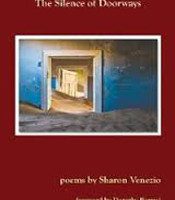“We must tell ourselves the right story about what we are doing,” Carol Potter advises a room full of writers. Don Miguel Ruiz offers his audience similar counsel as he reminds them their lives are stories in constant revision and they are the writers who can transform their protagonists from victim to hero, who can write themselves in or out of happy stories. In Sharon Venezio’s The Silence of Doorways, the speaker writes and rewrites her history in of search the right story. The poems use photography as a counterpoint to poetry (two ways of telling stories) and Venezio prefaces the book with a quote from artist and writer John Berger: “The camera relieves us of the burden of memory.” Venezio chooses poetry over a camera to take on the burden of memory.
Memory and art are acts of creation; each attempts to tell and retell — to preserve or deconstruct — our stories, or what we want our stories to be. Poems, unlike photographs, are mutable constructions that the poet may revise, contort, and rewrite; poems live in the motion of the voice. Photographs freeze the world, stop all motion and sound, and give the illusion of objectivity. Yet each photograph, like each poem, chooses a perspective that cuts out something and forces us to focus on its chosen subject. Memory, landscapes, objects, and bodies decay even as poems and photographs attempt to stop this. Venezio’s book struggles to work out the tension between preservation and decay, between sounding (poetry) and silence (photography).
The first poem introduces the speaker’s obsession with decay and the stopping of decay: “Even numbers have the power to stop death; odd numbers rot the brain,” ends the first stanza. This idea recurs in different forms from preservation through education versus decay through forgetting in “College Essay” to the sheep’s brain that “remembers the beautiful dying stars” to “the moonlight unstitching the stars” to the elegy for the photographer Francesca Woodman, “[UNTITLED],” which begins:
Where do you end and the world begin?
you want to be wind vapor
half flower half vase
wallpaper tree bark door
you become line shape
you invisible the self
Through all this the artists — the photographer and the poet — are charged with stopping the decay, with the burden of remembering. Yet, the opening poem “Obsession,” after presenting decay, poses photography as a type of death
2. If he speaks for her, she learns to keep her lips still, the shutters
slid shut. If not talking is a kind of death, he has killed her. A
cluster of numbers rotting in the throat.
In later poems, we learn the photographer is the father, the silenced is the mother “(she sews the day shut;/ her needle works the silence)” and the bird (another recurring image throughout the book) is the poet “swollen with song.” This song is not just the speaker’s, but also a speaking for parents who have not found ways to speak, is an effort to counteract the death/silence of the photograph and to preserve a new storyline. From “Meanwhile, An Obsession”:
sick of pulling at the sky of myself and this restless mirror like a raven
beating on this cold smooth pane a vague impression he thinks he might
remember my name he tells me I look unhappy his face a primordial
fossil a roar from deep within I open my mouth and howl
The obsession moves in this ten part series from the soundlessness of pictures to the sounding of poetry. Yet, in preservation, as the elegy (“[UNTITLED]”) asks, how much of the self is revealed or erased?
Venezio’s poetry negotiates the space between the directness of confessional modes and the abstractions of language poetry to emerge as poetry of quiet revelations. While best exemplified in “Meanwhile, An Obsession,” this balance is seen throughout the book, which Venezio structures as a photography exhibit.
The first section, “Landscapes,” sets up not so much a physical location, but the emotional setting of this quest to preserve and articulate the ephemeral and the unspeakable. A poem in the form of a dictionary entry reveals the father/photographer as suppressor of the natural instinct to sing and blossom as he takes on the role of preserver of family/memory. In “Now We Become Ghosts,” traditional narrative cues, such as “When” to “Now,” are belied by lyricism in favor of narrative, “Now, as the aperture of morning/ expands over California, / my father is a ghost in the camera lens / collecting variations of light.” Thus the speaker tries out ways to tell that right story, a story that cannot be told through the language of the father.
The “Single Exposure” in the second section is the one poem, “Meanwhile, An Obsession,” the poet’s quest to both locate the subject of the self and to avoid containment of the self: “…this is the main point of vulnerability his hands on my face while inscribing a brand new class to locate and contain the subject.” A series of prose-like segments without punctuation, the poem moves through multiple perspectives, yet the fluid imagery and the carefully (obsessively) chosen language leaves the me with a sense of being trusted with these confessions of a person that wants to “avoid annihilation.” Like the speaker I am left only to “accept the page I’m reading the words before me the dying.” In reading, I work with the poet to preserve what cannot hold. This leads directly into “Portraits,” a section invites us to flip through selections from a family photo album: the father who hides behind the camera lens; the ghost of a the self-destructive brother; the speaker/poet seeking a way out in cigarettes, bars, and her first car, a “Brown Nova had no past, / only the moon’s/ emerging promise”; and the mother who “measures the distance/between wife and lens, // migrates inward.” Like photos, even as we hold these tangible objects, the stories behind them remain slippery and shadowy, subject to choices of memory.
 “Multiple Exposures” is the quest of this heroine’s journey, the moving out and the seeing. The poet preserves and re-imagines what was learned by emulating the mentors she met along the way. “Water Asks a Question after Nick Flynn” witnesses the danger of silencing others while “Poems of Submission after James L. White” reveals the danger in silencing the self: “I want to sit in the shrinking light/of my own body, which is separate/ from your body.” In “Poems for Freud,” it takes two sections — a “Self-portrait with defense mechanisms” and “Photographing the world/ from the driver’s seat/ of an air conditioned car” — before the I finds the courage to enter the poem.
“Multiple Exposures” is the quest of this heroine’s journey, the moving out and the seeing. The poet preserves and re-imagines what was learned by emulating the mentors she met along the way. “Water Asks a Question after Nick Flynn” witnesses the danger of silencing others while “Poems of Submission after James L. White” reveals the danger in silencing the self: “I want to sit in the shrinking light/of my own body, which is separate/ from your body.” In “Poems for Freud,” it takes two sections — a “Self-portrait with defense mechanisms” and “Photographing the world/ from the driver’s seat/ of an air conditioned car” — before the I finds the courage to enter the poem.
Finally, in “Over Exposures” the speaker embraces the courage of the confessional voice to open the self, to grieve, to speak. She has found her own power: “Each night I watched the moon. / Each night I closed my eyes/to make it disappear.” She knows how to control exposure to create the image she wants to preserve. Thus, the speaker, through language and image, finds her way back, just as she counted “the number/of steps out of a movie theater/ so I can count my way back through the dark.”
As the camera shutter opens to let light in the aperture, so Sharon Venezio’s debut collection gives us a first glimpse of a poet whose craft is rooted in a deep experience of what it is to be human and to be an artist, to find your right story. In “Self-Portrait as a Camera,” she writes, “My shuttered lens opening/like a tiny mirror, / like the hungry aperture of light.” Thus she leaves her reader feeling both illuminated and hungry for more.




